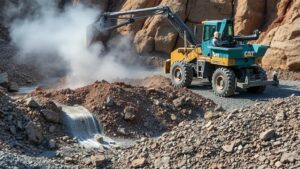Using Free Online Resources to Research Prospecting Locations
Using Free Online Resources to Research Prospecting Locations
In todays digital age, substantial information is readily available at our fingertips, providing valuable insights for various fields such as mining, geology, and real estate. For prospectors seeking new locations, free online resources offer a wealth of data, making it easier than ever to conduct comprehensive research. This article explores effective strategies and tools for utilizing free online resources in prospecting research.
Understanding Prospecting
Prospecting refers to the process of identifying areas where valuable resources, such as minerals or real estate, can be found. It requires careful analysis of geological data, historical records, and environmental considerations. For this task, a variety of online resources have emerged that can significantly enhance a prospectors ability to make informed decisions.
Key Online Resources for Prospecting Research
Several free online platforms offer essential information for prospecting efforts. The following categories provide access to geological data, historical mining records, and regional statistics:
- Geological Surveys: National geological surveys often publish geological maps and reports. Websites like the United States Geological Survey (USGS) provide comprehensive data on mineral resources, geological hazards, and topographic maps.
- Mining and Mineral Exploration Databases: Platforms such as Mindat.org and the Mineral Resources Data System (MRDS) boast extensive databases on mineral occurrences and their historical production statistics.
- Local Government Resources: Many state and local government websites host data on land use, zoning regulations, and environmental assessments, which are crucial for anyone considering prospecting.
- Satellite Imagery and Maps: Free mapping tools like Google Earth facilitate the analysis of terrain and landscape features relevant to prospecting.
- Academic Publications and Research Papers: Sites like Google Scholar provide access to scholarly articles that discuss geological formations and successful prospecting methods.
Utilizing Geological Surveys
Geological surveys are invaluable for prospectors. For example, the USGS provides several datasets, including the National Geological Map Database, which allows users to search and download geological maps. These maps reveal the types and distributions of rocks and minerals across different geographical areas, thereby helping prospectors identify promising locations.
Historical Data and Case Studies
Understanding the historical context of a location can also guide prospecting efforts. By studying historical mining records and case studies, prospectors can learn about past successes and failures. For example, examining mining records from gold rushes in California or Alaska can highlight fruitful areas and techniques that might still be relevant today.
Environmental Considerations in Prospecting
While prospecting can yield significant rewards, it is essential to consider the environmental impact of resource extraction. Free online resources such as the Environmental Protection Agency (EPA) provide guidelines and data on environmental regulations and land management practices. Understanding these factors is crucial for sustainable prospecting and maintaining compliance with local laws.
Real-World Applications
Many prospectors have successfully utilized free online resources in their endeavors. For example, a small company seeking gold in Nevada accessed geological maps and satellite imagery to identify unexplored locations. By combining data from geological surveys and local government environmental assessments, they were able to avoid areas of restricted access and focus on regions with high potential yields.
Actionable Takeaways
To effectively use free online resources for prospecting research, consider the following steps:
- Begin with geological surveys to identify potential locations and access geological maps.
- Use historical mining databases to pinpoint areas with past successful yields.
- Review local government websites for regulations and environmental assessments, ensuring compliance.
- Leverage satellite imagery to visually analyze terrain and access potential sites.
- Engage with academic research to stay informed on the latest geological studies and prospecting techniques.
To wrap up, the integration of free online resources into the prospecting process significantly enhances the ability to make informed decisions. By utilizing these tools effectively, prospectors can optimize their efforts and improve their chances of success in resource exploration.

